Here is a list of some of the local rock ‘n’ roll magazines and books of the 1950s, ’60s, and ’70s. If you know of others or have additions, corrections, or photos, please contact me!
Beat Magazine: John Pratt: “Beat Magazine was a national publication that was sold through various top-40 stations around the country, with editions tailored to each station’s markets. Here, it was KDWB Beat. KRLA had the Los Angeles edition of Beat; below is a cover photo of an October 1967 edition of KRLA Beat.” The address given is Beat Publications, 9125 Sunset Blvd., Los Angeles.
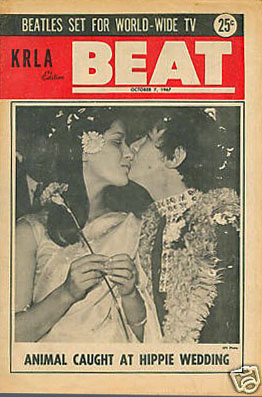
I have photocopies of four issues of KDWB Beat. Each has a “local” page centered on the station. The local page from the August 26, 1967, issue (“Special Hippie History Issue”) featured pictures of Twin Cities music industry folk (Tac Hammer, Ira Heilicher, Charlee Brown) with the Jefferson Airplane, the Electric Prunes, and the Shadows of Night during an outing on Lake Minnetonka. The issue also reported on the Monkees concert in NYC, where the opening acts were Lynn Randell and Jimi Hendrix. Micky did his best James Brown imitation.
The local page from October 21, 1967, reports KDWB’s Earl L. Trout III being “jailed” in a charity stunt. It shows him broadcasting live from the corner of 7th and Hennepin, and Minneapolis police “arresting” him and taking him to jail until enough money was raised for the Leukemia Foundation to “bail” him out.
The January 27, 1968, issue featured a silly “history” of KDWB going back to the cave men. It also supported a High School Christmas concert series involving 13 schools from the metro area (including St. Louis Park).
And the February 24, 1968, issue featured KDWB DJ Earl L. Trout III’s national-but-futile letter-writing campaign to bring the Beatles back to the U.S.
Buzz, Published by City Pages (Tom Barthel, Nate Wolk, Ira Heilicher), November 1985 to June 1988, according to microfilm records at the Minnesota Historical Society. Little to no local content.
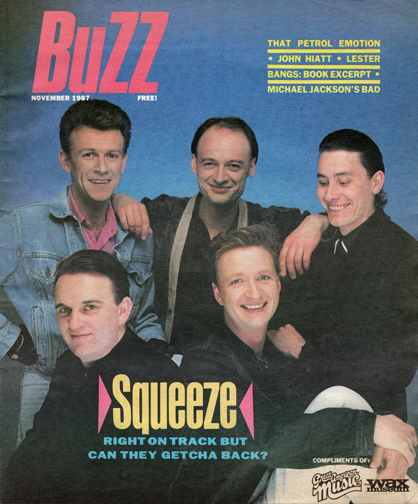
Image courtesy Dennis L. Libby
Cake: November-December 1990 – 1997, according to microfilm records, Minnesota Historical Society
City Pages: Music and Entertainment, plus news and Features for People Living in the City. Continuation of Sweet Potato Magazine. The first issue was December 3, 1981. If you wanted to know what went on musically in the Twin Cities, City Pages was where to find it.
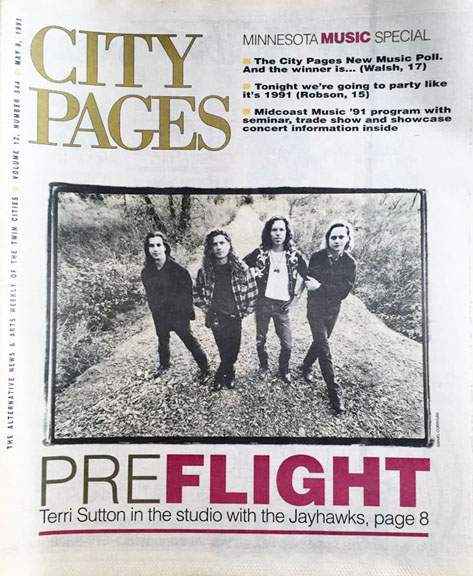
On October 28, 2020, the paper’s owner, Star Tribune Media Co., announced that The City Pages would stop publishing and close immediately.
The Star Tribune‘s Evan Ramstad reported:
The company said it could no longer sustain City Pages after the coronavirus outbreak forced closings and downsizings of the events, nightclubs, bars and restaurants that were its chief advertisers and financial base.
With the closing, 30 people will lose their jobs. It adds Minneapolis-St. Paul to the growing list of U.S. cities with no more so-called “alternative” newspapers, which rose out of the 1960s counterculture scene and flourished through the 1990s, throwing sharp elbows in political coverage and spotting the edgiest ideas in arts.
“While City Pages has retained a strong brand in our market, the profound disruptions of the COVID-19 pandemic have made it economically unviable,” Mike Klingensmith, chief executive of Star Tribune Media, wrote in a note to employees.
He said he doesn’t think the businesses that City Pages relies on for revenue will soon recover. “Even when they return, they will be many fewer in number,” Klingensmith wrote. “This leaves us no feasible options other than a shutdown.”
The last print edition of City Pages will be distributed this week. The company is making plans to preserve the print archive of City Pages. Its website will remain online for an unspecified period of time, the company said, but it will no longer be updated.
The publication started in 1979 as a monthly newspaper called Sweet Potato that was devoted to the local music scene. But by 1981, founders Tom Bartel and Kristin Henning were eager to grow the business. They decided to expand its coverage and change into a weekly, which they named City Pages, to challenge an alternative weekly called Twin Cities Reader.
“And the Star Tribune,” said Bartel, who with his wife Henning, now publishes an online travel site. “What I was proud about is we got people out of jail and we put people in jail. We did a lot of really good stories.”
In the 1990s, City Pages won awards for stories about brutality by the Minneapolis police force and was sued by the police union over a story about racism, topics that reverberated in the city again this year. It won its first Premack Award, then the state’s highest honor in journalism, in 1991 for coverage of Northwest Airlines.
“We believed if we did good stories we would get readers, and if we had readers we would get advertisers,” Bartel said. “But that advertising model is completely broken.”
In offices across the street from each other, the two weeklies battled for readers, advertisers, and influence until the late 1990s when both were purchased by a New York firm, Stern Publishing, that owned the Village Voice and other alternative weeklies. The new owner promptly shut down the Reader.
Over the next decade or so, City Pages survived while other weekly and monthly publications aimed at the Twin Cities arts scene, such as Rake, Siren, and Toast came and went. Its owner, meanwhile, merged with another owner of alt-weeklies, consolidating the industry just as internet companies eroded its base of classified advertising and social media changed reading habits.
Star Tribune Media five years ago purchased City Pages from Village Voice Media, a successor to Stern. At that time, Star Tribune Media was the third major daily publisher to buy an alternative weekly.
In 2012, the owner of the Chicago Sun-Times bought the Chicago Reader, and in 2014 the Baltimore Sun bought the Baltimore City Paper. But the Sun closed the Baltimore City Paper in 2017, and the Sun-Times sold the Chicago Reader a year later. This year, the Chicago Reader, citing effects of the pandemic, reduced its print schedule to every other week.
When the pandemic lockdown in March created an immediate drop-off in advertising at City Pages, Star Tribune executives took a wait-and-see approach.
“The calculus was this is a very talented team. They know the market, they know their customers. And we don’t know if this will be a two-month thing or what,” said Steve Yaeger, chief marketing officer at Star Tribune Media.
In July, City Pages produced its annual “Best Of” issue that was popular with readers and usually stuffed with advertising. But it warned that some of its “Best of” awards were already out of date. “Due to COVID-19, the uprising, or the uncertainty in the aftermath of both, we’ve lost plenty of beloved businesses — for now or forever — that might otherwise be here today,” an introduction to the feature said.
“It was rough before 2020 for this kind of publication,” Yaeger said. “It just got a whole lot rougher and caught up with City Pages in a way that none of us would have anticipated at the start of the year.”
The company said City Pages staffers will be offered severance and be eligible for news and advertising jobs that are open at the Star Tribune.
“Fortunately, the Star Tribune is in a strong position due to the majority of its revenue coming from digital and print subscriptions, complemented by support from a large base of regional and national advertisers,” Klingensmith said.
Connie’s Insider – See Insider.
The Entertainer was published by Metro College from (as far as I can figure) January 23, 1976 to January 7, 1977, according to microfilm at the Minnesota Historical Society. Continued (with same volume and issue numbering) as the Twin Cities Reader on January 14, 1977 to February 26 – March 12-18, 1997.
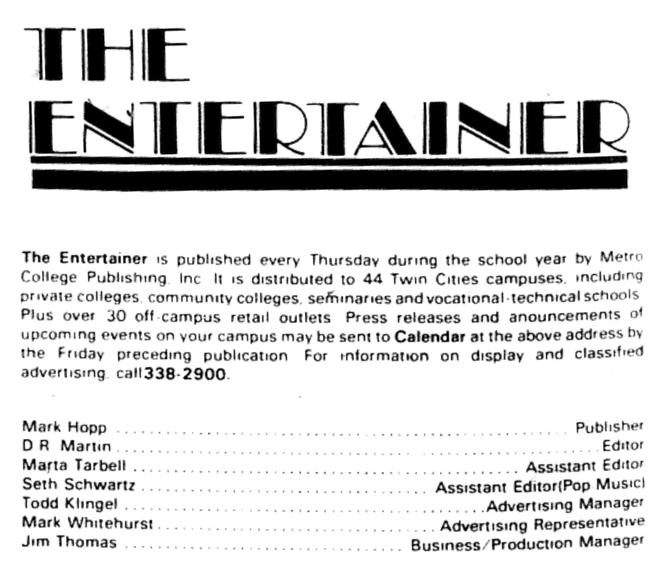
Fanfare was the newsletter of the Minneapolis Musicians’ Union Local 73. Unfortunately I’ve only located a single copy! If it’s as useful as the newsletter issued by their sister (St. Paul Musician, below), it must contain a wealth of information, but nobody seems to have them. The Minneapolis union was incorporated in 1891 and chartered on June 8, 1901. The two unions merged in 1981, and the current newsletter is called (appropriately enough) Duet.
Flip Side: An Illustrated History of Southern Minnesota Rock & Roll Music from 1955-1970; Jim Oldsberg, 1997.
Thee Apostles/Stormy Monday; Little Caesar & The Conspirators; The Chances R; The Continental Co-ets; The D.C. Drifters; The Defiants; The Depressions; The Emperors; The Epicurians/Highway; The Exotics/19th Amendment;; The Ferraris; The Furys; The Gestures/Madhatters; Mike Glieden & the Rhythm Kings; Steve Carl & the Jags; The Korners of Time; Kreed; Leaves of Grass; The Messengers; The Mods; The Mustangs; The Night Crawlers; The Nite-Sounds; The Notorious Noblemen; The Pagans; The Pilgrims; Prince & the Paupers; The Radiants; The Rhythm Rockers; The Rogues; The Secrets; The Shades; The Shags; The Silver Shadows; The Sensational Sleepers; Steve Ellis & the Starfires; The Stingrays; TBI; Us; Vultures; Wire
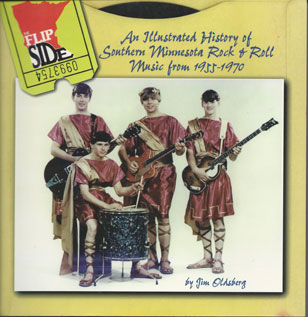
Good Times began as the Zenith Express in 1973 (see below).
The November 12, 1977, issue proclaimed that it focused on entertainment, leisure, sports, arts, dining, and shopping. The Editor was Dave Hill, and the Publisher was Edward J. Molitor. In 1978, Molitor was both the Editor and Publisher.
Continued as the Metropolitan.
Hair was an underground paper published in 1968-69. Issue 2’s cover featured a naked girl with a breast in her cereal bowl with the caption “Some mornings nothing goes right!” Publishers and contributors included Evan and Sally Stark, Jack Cann, Steve Kimmel, and Gus and Marsha Slelzer. Much of the content was on local housing news, including reports on the condition of housing, particularly on Nicollet Island. One issue had a long article on “Yellow Submarine” but I couldn’t make out whether they liked it or not. In April 1969 there were very big ads for Labor Temple shows.
Hundred Flowers was a short-lived but extremely influential publication edited by Warren Hanson, Ed Felein, and Dick Dworkin.
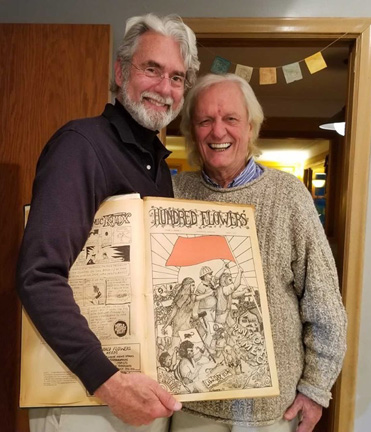
Hanson and Felein in 2019
It was published from April 17, 1970 to April 4, 1972. A low-budget affair, it had hand-drawn artwork (see Record Stores for their great ads) and cut-and-paste layouts.
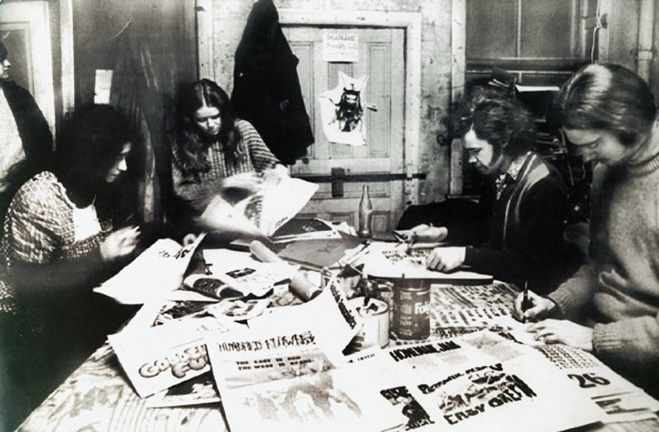
Layout session – photo courtesy Doug DeMille
The name came from a quote from Chinese Communist Party Chairman Mao Zedong during a period in 1956 where the Chinese people were encouraged to share their opinions of the regime: “The policy of letting a hundred flowers bloom and a hundred schools of thought contend is designed to promote the flourishing of the arts and the progress of science.” The course was soon reversed and may have been a trick to flush out dissidents.
Offices of the magazine were first located in the Eastside Citizens’ Community Center at 100 University Ave., but they reported that they were kicked out. By 1971 they were located at “Liberty House,” 529 Cedar Ave. So., operated by Minneapolis activist Marv Davidov.
It was primarily a political underground newspaper, publishing communiques from Bernardine Dohrn of the Weather Underground. But it had some music reviews and ads in it as well. In its January 1, 1971, issue it reported a rash of thefts of local instruments. It also complained that the Depot had withdrawn its free tickets to the paper’s staff because of critical reviews of its concerts. They responded by calling the Depot a “smoky, smelly, overcrowded plastic environment to hear often outrageously loud performances.. pathetic efforts at pleasure.” It also reported on an experiment where pregnant women took LSD. They reported no birth defects, but all the babies turned out to be girls. The sample size was… 10.
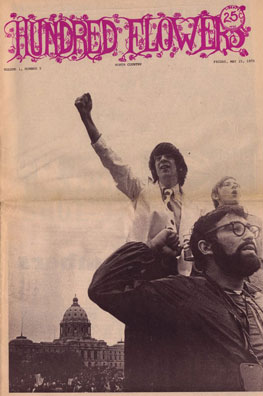
In-Beat Magazine (“That’s What’s Happening”): This magazine was published monthly by Steven Kaplan out of his living room. Kaplan sold subscriptions at the Teen Age Fair at the State Fair [presumably August 66] for $2 – each subscriber got a free 45 rpm record, so the subscriptions were essentially free. In-Beat paid Twin City a Go Go (see below) $1500 not to compete. The first issue came out in September 1966.
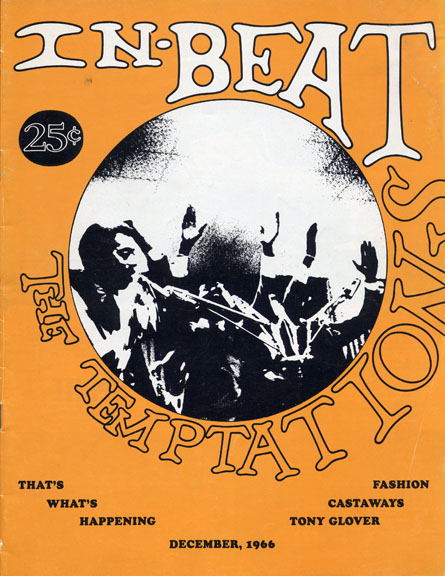
Kaplan remembers:
We were out only a few issues when we got some good national ads: Sprite automobiles and Clairol products among them. A coup for a small magazine.
Also, a few months after we were out, the publisher of Where magazine called and wanted to meet. By this time our magazine was hot: I went from being a nerd to being hip in two issues (and back to being a nerd again after we stopped publishing). But we were hot and this publisher wanted us to associate our name with his, so he offered us an office — for free — and, this was the clincher, free meals every day at Luigi’s restaurant, which at that time was on the main floor of the Lumber Exchange, where Where was located (on the 12th floor). We took the office and were able to move out of my apartment. It was a big office and we always kept the doors closed because it reeked of marijuana fumes.
One of our biggest coups came early in the season. Big names Chad & Jeremy (though, of course, no one today has any idea of who they were) were booked for the fair, but never showed up. It was an outrage and everyone — particularly the mainstream media — was trying to find out what happened. Chad & Jeremy called us, however, and sat down for an explanatory interview with us, the only interview they gave (and, perhaps, the last one anyone ever really cared about).
Our best time was with James Brown. He had come (maybe to the Flame Ballroom) and we made arrangements to photograph & interview him. Brown was my personal idol and I couldn’t wait to see him perform. We went to the concert and though it was sold out, there was hardly a white guy there: maybe 3 or 4 in the whole place (Danny & I were half of that). When the show was over we went back stage where Brown, who was indeed the hardest working guy in show business, was sitting at a chair with an attendant at both legs, each unlacing his high-laced boots. I started asking him my brilliant questions when he stopped me. “This is no place to do an interview,” he said, and, of course, he was right. “Why don’t you guys fly back with me to Cincinnati. That way we can do the interview on the plane, and it will be quiet and we won’t be rushed. After I’ll put you guys up in a hotel and in the morning we’ll tour King Records.” And that’s exactly what we did. We flew back in his Lear Jet, he, James Foxx, Danny & I. The plane’s interior was about as big as a restaurant booth, and the loudspeakers played Vivaldi.
The (final?) issue of In-Beat came out in August 1967. Kaplan and friends went to San Francisco for the Monterey Pop concert in 1967, where hippies were in and teenage fanzines were out, and that was the end of In-Beat.
Insider: See separate page for all iterations of the Insider.
Johnny Green and the Greenmen by Mark Starks, 2010.
Little Sandy Review, edited by Paul Nelson and Jon Pankake, 1960-1968
This was a little paperback-sized magazine that contained mostly reviews of folk recordings. Although the issues are not dated, it is estimated that the first issue came out in March 1960, at the very dawn of the folk music era. Initial cost was 30 cents, and the office was listed as 3220 Park Ave. So. in Minneapolis (Paul Nelson’s home). The name was a poke at the “Little Sandys” (girls who wanted to be Sandra Dee) on campus. There was not much local content. The editors were folk and blues purists, and launched often hilarious blasts at “all phonies who water, dilute, and pervert” folk music. It was very clear who they liked and who they thought were purveyors of “folkum.”
Likes:
- Woody Guthrie
- Pete Seeger
- New Lost City Ramblers
- Dylan’s first album
- Peggy Seeger
- Joan Baez (off and on)
- Ramblin’ Jack Elliott
- Jean Ritchie
- Leadbelly
- Carter Family
- Cisco Houston
- Koerner, Ray, and Glover
- Stringbean (“important, gifted, and versatile country musician”)
Hates:
- Harry “Belaphoney”
- Kingston Trio
- Limelighters
- Coachmen
- Bud and Travis
- Josh White (“basks in moneyed glow of the expense account set”)
- Glenn Yarborough (“sounds like a male Judy Garland”)
- Odetta (“a poor musician”)
- The Weavers (“not much more ‘folk’ than Jo Stafford – just know how to play-act better”)
- Burl Ives (“darling of suburban matrons”)
- Jimmie Rodgers (mad because he claimed he wrote traditional songs)
- Smothers Brothers (“not folk and not funny”)
- Peter, Paul, and Mary (“atrocious artificially canned, commercial enthusiasm”)
Bob Murphy of the Minneapolis Star wrote a long article about Nelson and Pankake on October 13, 1960, when Number 7 was just off the press. At the time there were 300 subscribers to the magazine, heavily augmented by New York readers.
Nelson was described as a part-time U of M student who worked in the stockroom of a record distributing firm. Pankake was also a U of M student, who also worked as a garbage collector on campus. Both performed, but not professionally, playing multiple instruments. Pankake owned a 12-string guitar, “an instrument played now only in the folk music field.” They had a library of several hundred folk albums.
The proceeds of The Little Sandy Review went to buy more records and pay wages for reviewers and staff. The magazine was originally run off on a mimeograph machine, and Pankake did most of the artwork.
Barry Hanson was the main blues reviewer – he went on to become Dr. Demento. He moved west but continued to contribute. In January 1964 the magazine graduated to professional printing and slick paper and the price went up to 85 cents. The next issue came out in March and was $1. Then there was a gap until 1965. After that started Volume 2 in July 1966, and the magazine had moved to California, edited solely by Hanson, although Nelson (who had moved to New York to work at Sing Out!) and Pankake had offered to contribute. Another three issues came out but the last was in about February 1968. Bound copies are available to read at the downtown Minneapolis library.
Lost and Found: a ’50s/’60s Rock & Roll ‘Zine; Jim Oldsberg
Volume 1: Minnesota/Iowa, November 1992
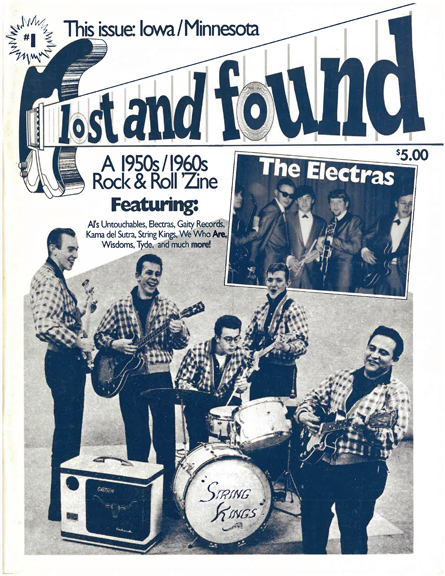
Table of Contents:
- David Hersk/Gaity Records
- String Kings
- Wisdoms
- We Who Are
- Tyde
- Electras
- Kama Del Sutra
- Ivymen
- Al’s Untouchables
*Volume 2: Minnesota/Wisconsin, December 1993
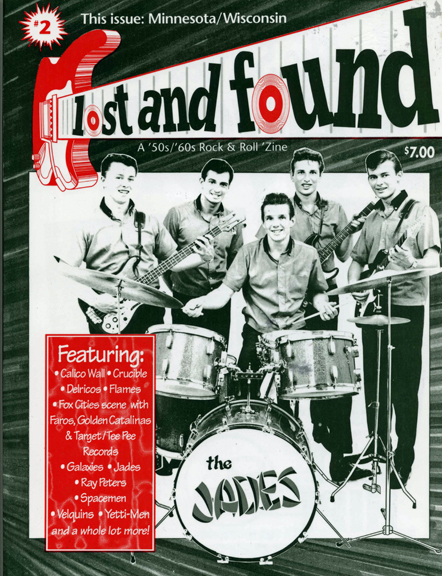
Table of Contents:
- Jades
- Benders
- Velquins
- DelRicos
- Flames
- The Fox Cities Scene
- Golden Catalinas
- Faros
- Memories
- Private Property of Digil
- Lord Beverly Moss & The Moss Men
- Denny Noie/In Crowd/4th of Never
- Journeymen, Target/Tee Pee Records
- Yetti-Men
- Calico Wall
- Crucible
- Galaxies
- Spacemen
- Aldon & the E.C.s/Thundermen
- Behind the Scenes – Ray Peters
*Volume 3: Illinois/Minnesota. November 1994
Table of Contents:
- Sonics
- Ready Men
- C.A. Quintet
- Behind the Scenes – Steve Longman
- ’60s Chicagoland – The Second Tier
- Dimensions
- Vectors
- Long John & the Silvermen
- Nobody’s Children
- Graf Zepplin
- Behind the Scenes – Erwin “Dutch” Wenzlaff
- ’60s Chicagoland Radio
- Kan Dells
- Stillroven
- Paegans
- Accents
- Rave-Ons
- Mercymen
- Blues Effort
- Deacons
*Volume 4: North and South Dakota, December 1995
Table of Contents:
- Ronnie Ray & the Playboys
- Davey Bee & the Sonics
- Richie Wynn & the Tornadoes
- Terry Lee & the Poorboys
- Stevie & the Shades a/k/a The Fragile Zookeeper
- Pawnbrokers
- Escorts Four
- Steve Rowe & the Furies
- Treasures
- Bobby Vee & the Shadows
- Boss Tweads
- Sir Laurence & the Crescents
- Teen Dance Nights to Remember
- Behind the Scenes – Ken Mills
- Dale Gregory & the Shouters
- Jay Bee & the Kats
- Memories of the Shattoes/Chateaux by their #1 Fan – Harlan Busch
- Bleach Boys
- Myron Lee & the Caddies
*Volume 5: Northern Minnesota, December 1997
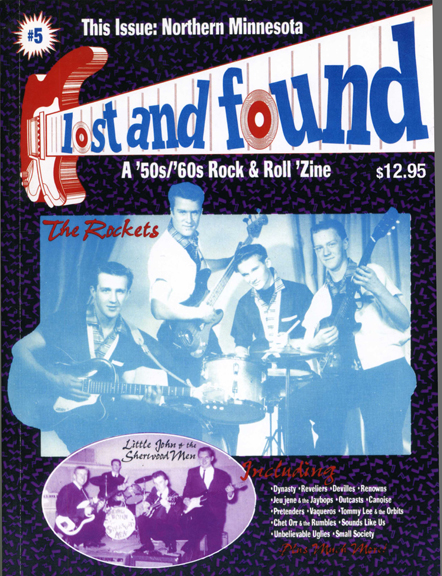
Table of Contents:
- Rockets
- Little John & the Sherwood Men
- Reveliers
- Renowns
- Tommy Lee & the Orbits
- Jeujene & the Jaybops
- Canoise
- Avengers
- Pretenders
- Chet Orr & the Rumbles
- Howie Butler & the Reflections
- Outcasts
- Titans
- Sounds Like Us
- Devilles
- Vaqueros
- Unbelievable Uglies
- Novas
Machete was published from December 15, 1978 to December 1980, according to microfilm records at the Minnesota Historical Society.
Mark Simonson provided the history of Metropolis, below, which gives the background to Machete. He continues,
Some of the staff at Metropolis were local, including me. After Metropolis folded, several of us—me, Tony Schmitz and Patricia Ohman—started Machete. I did all the art direction, design, and production. Tony and Patty did most of the writing. Photographer Paul Shambroom was a regular contributor. (He had also worked for Metropolis.) Machete was an irregularly published broadside, just two large pages at first, but expanding to four later on. There wasn’t actually much music coverage in Machete. It was mostly about current affairs and topics that interested Tony and Patty. Machete carried some advertising, but it wasn’t enough to cover expenses and the printing was mainly funded out of our pockets. You could say that it was vanity press.
Metanoia was a local arts magazine. Kurt Thometz, who was involved from Issue #3, tells us that it was “edited by Glen Lake’s literati Mike & Dave (aka Bird) Thomson.” Their storefront was at 2108 South 4th Street. Tony Glover wrote concert and record reviews in a column called “Rock Revolves.” The magazine was distributed on the streets of the West Bank and Dinkytown. In 1968 it was said to have a circulation of 5,000, mostly college students and instructors. Thometz says, “Such fun!”
- Issue #2: The Evanescene Issue, 1967
- Issue #3: Poetry, Art, Views, Reviews, 1967. Published by M.T. Thomson, Paul Kihiman, Richard Zarro, David Thomson, Hopkins – 25 cents.
- Issue #4: Art, Poetry, Political Reviews: M.T. Thomson, David B. Thomson, Paul Kihlman, 2108 4th Ave. So.
- Issue #5: Slick paper, cost raised to 40 cents. “Explorations for a change of heart”
- Issue #6: October-November 1968. David Thomson, Editor; M.T. Thomson, Associate Editor. 2721 E. 42nd St. “Change of Heart”
- Issue #7: December – January 1969. Lost advertising; no longer slick; still 40 cents. David Thomson, Editor and Publisher; Susan Olson, Associate Editor. 1805 Emerson Ave. So.
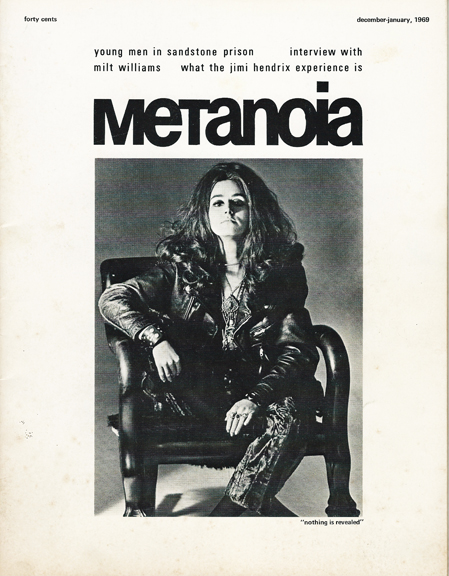
December-January 1969. Front cover photo by Mike Barich
Metropolis was published by Walter N. (“Trip”) Rothschild III. His nickname referred to the “III.” The magazine was published from October 19, 1976 to September 6, 1977, according to microfilm records at the Minnesota Historical Society.
Mark Simonson wrote in with some incredible details about this interesting publication:
I was the production manager and assistant art director there from January 1977 until it folded.
Andy (“Seth”) Schwartz was the main music writer at Metropolis for most of its run. Andy subsequently went back to his hometown to become editor of the NY Rocker until it ceased publication. The music column in Metropolis was called “Blues, Rags, and Hollers,” a reference to the debut album of Minneapolis band Koerner, Ray, and Glover.
The writing staff of Metropolis was mostly recent graduates of the Harvard Crimson who all moved to the Twin Cities to start the paper, inspired by The Boston Real Paper and The Boston Phoenix. They picked Minneapolis because it was one of the few markets that didn’t yet have an alternative weekly, or so they thought. The Entertainer did exist, but they didn’t think it counted since it only covered entertainment at the time, not current affairs or other journalistic topics. Unfortunately, the business side of Metropolis was much weaker than the editorial side. The Entertainer, threatened by this new competition, incorporated more current affairs and journalistic topics in response and changed its name to The Twin Cities Reader to reflect this.
Metropolis was mainly funded by Rothschild’s trust fund. Competition for advertising between the two papers was a blood bath, and The Reader, with all its homegrown business ties, completely shut out this outsider enterprise. By the fall of 1977, Rothschild’s trust fund money ran out and he shut down the paper.
After Metropolis folded, most of the east coast people left.
The senior editor of Metropolis, Scott Kaufer, went on to become a TV writer, writing for shows such as The X-Files and Boston Legal. The managing editor, James Gleick, went on to become science editor at The New York Times and has written a number of popular books about science, including his best seller, Chaos, back in the 1980 as well as Genius, a biography of Richard Feynman.
The Midwest 60s Rock Art Collection by Tom W. Tourville, 1996. Features the Legendary Danceland Collection. Out of Print.
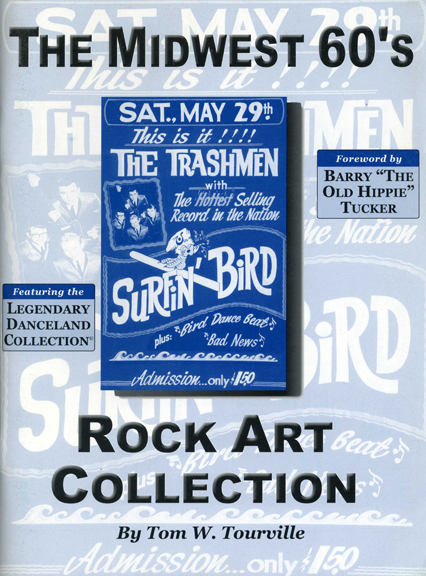
The Minneapolis Flag was a do-it-yourself newsletter than was political and musical, with some concert reviews in the April 10, 1970, issue. Classifieds were placed mostly by musicians and by photographers looking for “nice looking liberated chicks” to do nude modeling.
Minnesota Music Directory was first published in March 1981 by Sweet Potato magazine, and then each February from 1982 to 1987 by the City Pages. (Perhaps more but these are what the Minnesota Historical Society Library has in hard copy.)
Minnesota Rocked! The 1960s; Tom W. Tourville, 1966 (the fourth edition was the last.) This is an amazing list of Minnesota bands and their recordings. Out of Print.
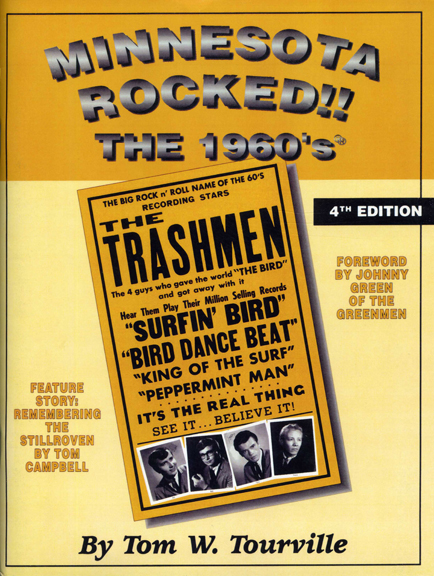
Music Legends: a Rewind on the Minnesota Music Scene; Martin Keller, D Media, Inc., 2007. See Amazon.
Music Scene was started by the B-Sharp Music Store, owned by Jim Lopes. The first four issues of Volume I were just dated April 1967, the second four were dated May 1967, and the last issue of Volume I was dated June 1967. These issues were edited by Timothy D. Kehr. When Connie Hechter, who had started the T.M.C. Insider the previous November 1966, heard about the new publication, he published a very angry response in the March 25, 1967, issue of his publication, saying that the market was not big enough for two similar music newsletters. The Music Scene’s content was mostly bios of local and national musicians.
After Tim Kehr had edited those first nine issues, Rod Eaton of the Underbeats explains what happened next:
Pat and I had been married just a few weeks in the early summer of 1967 when [the first] copy of the Music Scene appeared in our mailbox. Music Scene was a publication from B Sharp Music. It was four professionally-printed pages on nice paper and contained some interesting news about the local biz. It also contained lots of spelling and grammatical errors. Did I mention Pat was a teacher? Fresh into her summer break and looking for a challenge, Pat paid a visit to B Sharp’s Jim Lopes. She showed him her marked-up copy. (She can’t help herself – it’s in her DNA; she corrects the signs in Target.) Jim asked Pat if she could do better. “Damn straight,” she said. And that’s how Pat became the new editor of Music Scene.
For the next two months she and I interviewed musicians, wrote stories about things that concerned them, shot photos, edited submissions, sold ads, created layouts, glued paste ups, and performed all the other tasks that go into getting out a weekly newsletter. Actually, Pat did most of this since I was playing somewhere almost every night. It was fun but also sort of exhausting. So when Jim decided he’d stop publishing Music Scene, Pat didn’t shed any tears. Besides, it was just about time to go back to school.
Volume II of Music Scene ran from June 9 to July 28, 1967 (8 issues) for a total of 17 issues.
Musicians’ Insider: See Insider.
New Twin Citian: See Select
On the Rocks came to my attention thanks to Jeff Kleinbaum. This issue, Volume 2, Number 1, is from July 1989.
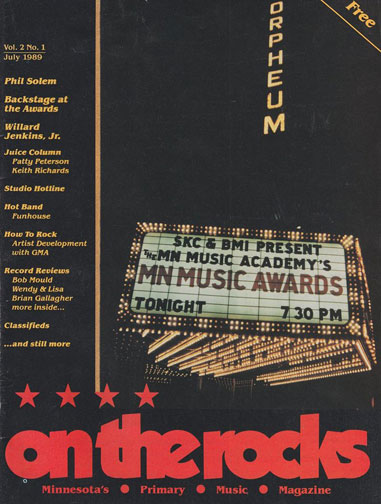
Pulse of the Twin Cities, published by Edwin Felien: Issues from April 9-16, 1997 to May 16-23, 2007, are available on microfilm at the Minnesota Historical Society. Back articles from 2002 to 2007 are on the Pulse website.
Rockin’ at Hatfield’s Hollyhock Ballroom, 2nd Edition, by Tom Tourville, 2015. In print at Amazon.com
From Amazon:
This volume covers over 1000 groups/artists that played over 950 shows at the famed Hollyhock between 1959-1981. There are over 350 images, graphics and autographs, many never seen before. This is all packed into 108 pages of rock and roll legend. The introduction for the book was written by Midwest rock and roll legend, Myron Lee of Myron Lee & The Caddies.
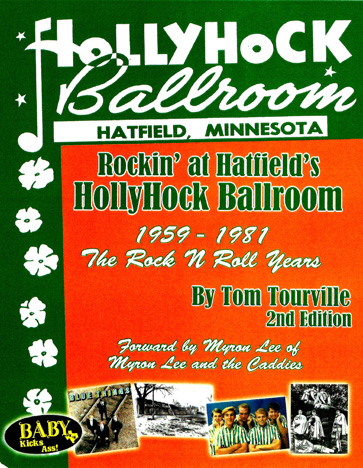
St. Paul Musician was the newsletter of the St. Paul Musician’s Union. It is basically an internal document, but it often has lists of venues and the names of the bands or musicians who are playing there. Mostly it gripes about those rock ‘n’ rollers and how nobody wants to listen to old-time music anymore. The Minneapolis and St. Paul Musicians’ Unions merged in 1981.
See Minneapolis was a tourist guide to the hotspots of the city, published by Howard L. Goldberg. It has huge color ads of some iconic venues.
See Twin Cities was yet another tourist guide, published by Robert L. Tait. The first volume came out on April 5, 1968. It lasted until about July 1971, but by then it had devolved to printing a lot of ads for “saunas.”
Select was not a music publication per se, but it did have a lot of great ads for night clubs for the sophisticated members of Twin Cities society. It also published a great directory of restaurants and night clubs each year. Copies are available at the Minnesota Historical Society. The progression of the magazine was:
- Select... The Magazine of Quality for Discriminating Minneapolis (September 1958 – February 1959)
- Select Minneapolis (March to April 1959)
- Select St. Paul (July 1959 to July 1960). Heavy on Hi-Fi ads.
- Select: Twin Cities Review of Fashion, Travel, Arts and Society (May 1959 to March 1962)
- Select Twin Citian: Minneapolis/St. Paul Review of Fashion, Travel, Arts and Society (April/May1962 – July 1963. Incorporated FM radio program listings in July 1962.
- Twin Citian: Minneapolis/St. Paul Review of Fashion, Travel, Arts and Society (August 1963 – June 1964) (Also see 1990 version of Twin Citian below)
- New Twin Citian (January to December, 1970). Included program listings for WLOL radio; no pop music listings
A Simple Twist of Fate: Bob Dylan and the Making of Blood on the Tracks; Andy Gill and Kevin Odegard; Da Capo Press, 2004. See Blood on the Tracks.
Sweet Potato: This precursor to the City Pages started as a monthly in August 1979. The publisher was Tom Bartel, and Martin Keller was the Editor (then the Music Editor). Sweet Potato sponsored the first Minnesota Music Awards (nicknamed the Yammies) in 1981. The last edition of the magazine was November 25, 1981, where it announced that the name was being changed to City Pages.
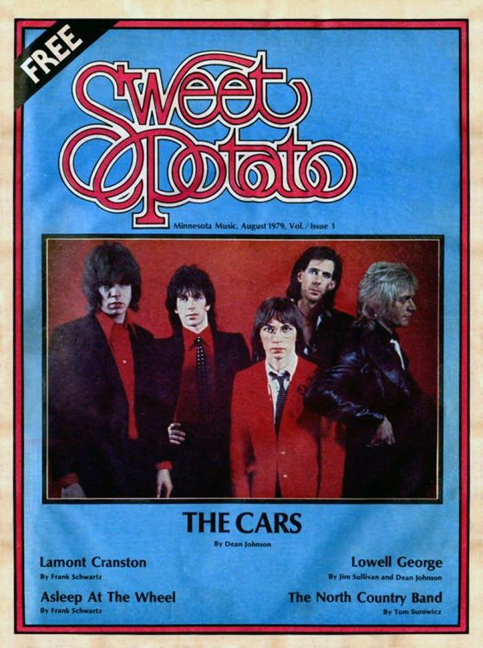
First edition, August 1979. Image courtesy Kenny Peterson
TMC Insider – See Insider.
Trax Magazine, “The music monthly,” was published from September 1979 to August 1980, according to microfilm records at the Minnesota Historical Society.
Twin Citian (1963-1964: See Select)
Twin Citian: Published by Adams Publications, 1990
Twin Cities Reader: Began as The Entertainer, which was published by Metro College from (as far as I can figure) January 23, 1976 to January 7, 1977, according to microfilm at the Minnesota Historical Society. (Started by Mark Hopp?) Continued (with same volume and issue numbering) as the Twin Cities Reader on January 14, 1977 to February 26 – March 12-18, 1997.
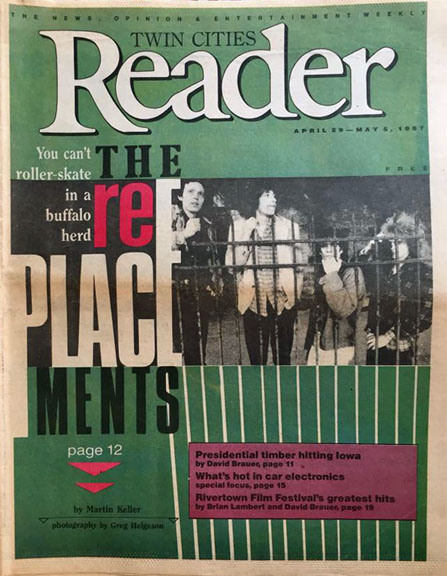
Remembering the Twin Cities Reader, 22 years after its death
The following article was posted on Minnpost on March 18, 2019, and was written by Burl Gilyard, who worked as a staff writer at the Twin Cities Reader from June 1993 until March 1997.
Twenty-two years ago this month, the Twin Cities Reader published its final issue. I remember it clearly because I was on the staff of the Reader at the time and all of us were very suddenly unemployed. There’s nothing special about the 22nd anniversary, but I find myself thinking about the Reader every year about this time.
The Reader, for those too young to remember, was a free weekly alternative newspaper that covered a mix of local news and arts. The printed edition was the only form in which it existed. The Reader had no web site. Smartphones and social media did not yet exist. The aging computer sitting on my desk was a PC called a “286.” Our idea of high-tech was the fax machine.
The Reader’s scrappy staff was collectively fired in mid-March 1997 because an out-of-town owner had recently acquired our direct competitor, City Pages. The same outfit then bought the Reader just to shut it down.
A humorless guy from New York stood in our threadbare office on the second floor of the Lumber Exchange building in downtown Minneapolis. He gave us the news that we already knew: we were out of business. It was a Wednesday afternoon; the latest issue of the Reader had just hit the racks. I had been working there for almost four years, my first “real job” out of college.
“Last day to operate is Friday,” he told us. There was nothing left to operate. We had two days to clean out our desks. After nearly two decades of battle, the guerrilla war of the weeklies in the Twin Cities was over.
In the grand scheme of the global media business, the Twin Cities Reader was a flyspeck. But looking back after more than two decades, maybe its shutdown was a small harbinger of the looming trouble for print publications everywhere: declining revenue, industry consolidation, steady layoffs and some guy from New York telling you that you don’t have a job anymore.
The metal newspaper racks for the Twin Cities Reader and City Pages were usually standing right next to each other in local bars, clubs and restaurants. Each paper had its partisans, but many readers picked up both. If one of the weeklies had a good story, people might keep talking about it all week long. Sometimes we found stories that the big media outlets missed. Sometimes we had more attitude than information.
In the big picture, the 1990s were good years for the alternative weekly industry. Business was booming in those pre-digital days because the papers drew younger readers who didn’t pay much attention to daily newspapers. In the days before dating apps and web sites, alternative weeklies ran “personal ads” — classified notices from people seeking romance. Ask your parents.
But the Reader was not cashing in on the trend: in its final years, it had fallen into second place as the smaller of the two papers. Despite being an elbows-out alternative newspaper, for many of its final years the Reader was part of a larger group of publications that was ultimately owned by an East Coast private equity group. Investing in the Reader was not a priority.
From the alternative weekly point of view, the big dailies were stodgy, humorless and not tough enough on the city’s big institutions. From the metro daily newspaper point of view, the weeklies were little tabloids: reckless, a bit sleazy around the edges, and full of stories with shaky sources, not to mention some occasional profanity.
Back then the idea of a major daily newspaper owning some grubby little giveaway rag like either the Reader or City Pages would have been seen by either side as preposterous. The weeklies were meant to be an “alternative” to mainstream media. But in 2015 the Star Tribune acquired City Pages and folded its own weekly arts and culture freebie, Vita.mn.
Today people find news everywhere: on web sites, devices, and social media. But at the same time it often seems that there are fewer distinct local media voices.
Back in 1997, the Star Tribune, St. Paul Pioneer Press, Twin Cities Reader and City Pages had four separate owners. Today the three surviving titles — all of which have smaller staffs than 20 years ago — have only two owners. Many media trendwatchers think that the number will ultimately be reduced to one. At that point, what’s the alternative?
Twin Cities Nightbeat: Published by Twin Cities Reader. Published biweekly starting December 1983; unclear how long it was/still is? published.
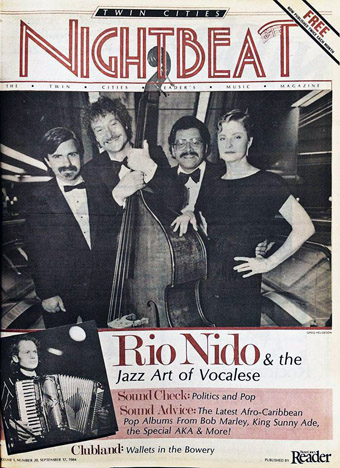
Twin City a-GoGo (“The magazine for Twin City Young Adults on the Go”): Editors were David Jass (vice-president of Young Adult Productions and son of Twin Cities television personality Mel Jass) and Bruce Goldstein (associated with Century Camera). This was a jam-packed publication. The first issue in May 1965 featured the Chancellors on the cover (see right). Free subscriptions were available until October 1, 1965. It grew to be a very popular publication: In 1965 there were 3 staff members, and by January 1966 there were 30.
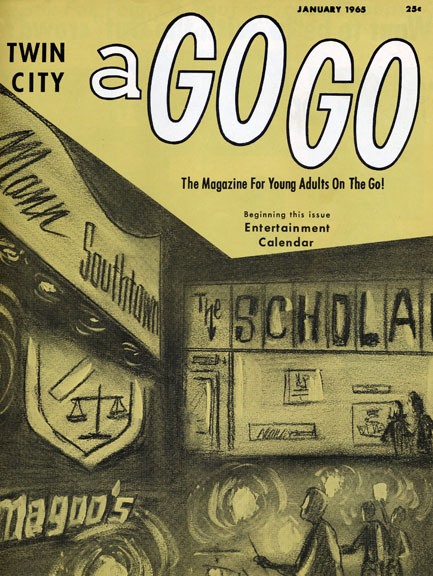
David Jass remembers:
We started all of this at the Teen Fair at the Minnesota State Fair [1965]. I think the teen fair only lasted that one time. We had a life-size display of the Beatles. Get your picture taken with the Beatles was a hit. It cost $.75. We also sold what we called go go hammers. The idea was to hit members of the opposite sex with them. It was a plastic hammer deal with accordion yellow ends that make a loud “pop” sound. We hired young ladies in swimming suits and tennis shoes to sell them. What a hit. By the 4th day of the Teen Fair we chartered an airplane to fly in more hammers. The last day of the fair I was in a cab going home. I had only one hammer left. Broken. The cab driver said his son had to have one. He paid me $1.75 for it. We also had kids sign up with name, phone, and address if they would be interested in a magazine for teens in Minnesota. Thus the list of finally 10,000 names.
I have the original copy of a’ GoGo . It is a small digest size mag of around 10 pages. Bruce and I wrote all the articles using pseudonyms. My fashion column “fling into spring” was my most memorable. We sold advertising to local businesses. Enough money was made to pay the rent for our office (above the Cascade 9 Bar and Grill in Mpls) and other expenses. Nancy Nelson was our secretary. We hired kids to call the rock n roll radio stations to plug our magazine. The radio stations started getting suspicious and stopped taking these calls. Kids would then call pretending some other “teen” topic and then slip in how much they loved Twin City A Go Go.
When the Beatles came to the Twin Cities, I had a room one floor below them at some motel in Mpls. I met them, not much talking, but a thrill for me. I was 21 at the time. During their press conference one of our guys (Karnstedt) tossed some issues of our magazine (#2) at the interview table. The boys picked them up and started clowning around with them. Our 3rd issue shows them with our magazine. Kind of cool.
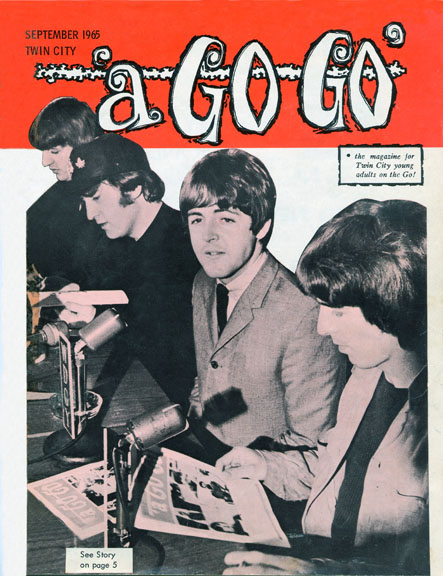
I left the corporation shortly after this escapade. My partner Bruce Goldstein continued for maybe one more issue. He began selling our list of 10,000 subscribers. I think that he sold the magazine, which was to become InBeat.
“Well, lots of memories here. I’ m now 64 years old. Have spent my working life as a teacher, social worker, and contractor. Have now lived in San Diego California for the last 30 years.
The Visitor – This Week in Minneapolis was one of many publications aimed at people in area hotels looking for a good time while in the Mill City. Although copies I’ve found start on January 10, 1948, the cover says it was established in 1934 – would love to see those! In 1948 it was published by John Q. Dunsworth, and James Mithun was the Editor. The publication apparently ended on January 4, 1964.
Waterfall – Monthly Magazine of the Cascade 9. I’ve seen Volume I, Number II, dated July 1972, but there’s no telling how many issues there were. Principals were:
- Editor: John Edmund Sharpe
- Associate Editors: Aubrey Chapin, Rhonda Cupcake
- Art Director: Dane A. Krogman
- Photography: William Keenan, Len Scuvver
- Sports Editor: Larry Bader
- Publisher: Jerry Agar
Publication Office was at 4249 Bryant Ave. So., Minneapolis.
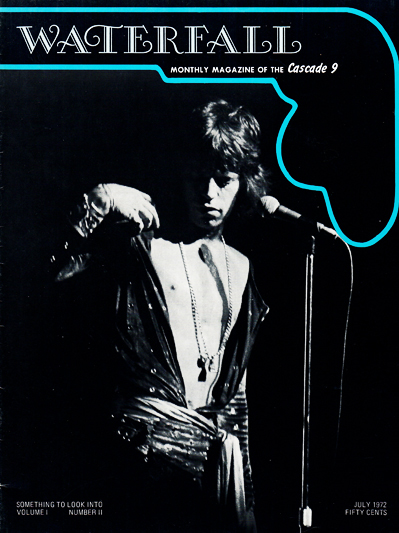
Cover, Volume 1, Isssue II, Waterfall. Cover photo by Mike Barich
Twin City Where was a nationally franchised magazine that published here in about 1966. Howard Goldenberg was the editor. It included many ads for restaurants and clubs (complete with reviews), weekly concert schedules, and toward the end, ads for massage parlors.
There may have been another Where. At Special Collections at the Downtown library there are copies from October 1967 to 2006.
Zenith Express was “the good times college magazine,” which, by extrapolation, was first published in 1973. No copies exist at the Minnesota Historical Society, but a gift from Paul Strickland of the Spring/Summer 1976 Minneapolis/St. Paul issue reveals that the publisher was Edward J. Molitor, and the Editor was Jerr Boschee. It was published bi-annually and distributed free to college students by Zenith Publishing Corporation – the address was a duplex in Edina. The 65-page magazine was chock-full of great advertising.
By at least November 12, 1977, Zenith Express had been rebranded Good Times, again with Molitor as publisher. From there it continued as the Metropolitan; no information available about that.
Marcia from Marcia and the Lynchmen reports that they were one of the teen bands highlighted in the St. Paul Pioneer Press Pictorial Magazine, June 5, 1966, “Those Teen Bands.” The article was entitled “Behind the Twang of the Guitar” and the text was by Bill Diehl. Maddie Shay scanned her copy for us!
